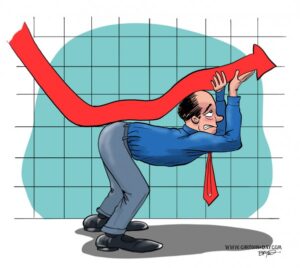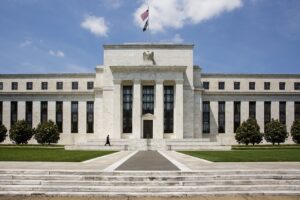Jun
4
The “Wonders” of the Biden Economy
“Although the pandemic recession was the shortest recession on record, the economic chaos it created was incredible.” — Andrew F. Puzder, businessman and author

This week I present an excerpt from a recent talk given by Andrew F. Puzder at a Hillsdale College National Leadership Seminar. If, like me, you are not familiar with Puzder, here’s a bit about him: he is a former chief executive of CKE Restaurants and current chairman of the board at anti-ESG investment firm 2ndVote Advisors. He holds multiple fellowships (e.g., at Pepperdine University School of Public Policy) and is the author of articles (e.g., for the WSJ and Real Clear Politics) and books (e.g., The Capitalist Comeback: The Trump Boom and the Left’s Plot to Stop It). He also served as an economic advisor for Trump’s 2016 presidential campaign.
The current U.S. economy is in sad shape, and our “economic freedom” ranking is at an all-time low. Yet, President Biden and many Democrats keep pushing the “everything is great!” message. Puzder serves up some facts that should disabuse any fairminded reader of that particular fiction. He also offers some good advice, along with the reason why Biden et al. won’t follow it.
— — —
“Just about everybody on Wall Street knows, despite what you read in the financial press, that the Biden administration’s economic policies are driving our economy into a recessionary ditch. In a recent Wall Street Journal survey of 23 large financial institutions that do business directly with the Federal Reserve, 16 predicted a recession in 2023 and two predicted a recession in 2024, while only five predicted that we would avoid a recession — although even those five predicted we’d have only one-half percent economic growth, well below the 2.1 percent average over the past 20 years and dangerously close to what has traditionally been considered a recession.
A recession is defined, traditionally, as two consecutive quarters of negative economic growth. At least it was defined that way before the financial press redefined it prior to the 2022 midterms, ensuring that despite two consecutive quarters of negative growth, President Biden’s policies couldn’t be labeled recessionary. But regardless of the definition, this negative growth meant declining standards of living, fewer job opportunities, lower wages, and increased poverty for the American people. Overall, we have become a far less vibrant and far less prosperous society on the verge of a serious recession.
The hard economic times we are experiencing are especially striking as they come on the heels of the Trump boom, which opened our eyes again to American economic potential when we have low taxes, reduced regulation, and a bountiful supply of domestic energy. Everybody, particularly minority and low-wage earners, reaped the benefits in the Trump years of abundant job opportunities, increasing wages, historic highs in family income, and historic lows in rates of poverty and unemployment.

Consider some of the metrics. In 2019, the last year before the pandemic, median family income grew to nearly $73,000. It went up $4,600 in that year alone, a 6.4 percent increase over 2018 — the largest annual increase going back to 1967. That amounted to 45 percent more growth in one year than the $3,200 increase that the Obama administration achieved in eight years. And contrary to what would become an election year talking point, the economic benefits were widespread. Every racial group experienced a record high median family income level: for white Americans it rose 5.7 percent; for black Americans, 7.9 percent; for Hispanic Americans, 7.1 percent; and for Asian Americans, 10.6 percent.
As incomes grew in 2019, the poverty rate plummeted 1.3 percentage points to a 60-year low of 10.5 percent — the lowest poverty rate since the government started reporting the statistic in 1959. This lifted 4.1 million people out of poverty. For comparison purposes, during the eight years of the Obama administration, the number of people living in poverty increased by 787,000. And again, the decrease in the poverty rate under Trump disproportionately benefited minorities: the poverty rate decreased eight-tenths of a percentage point for whites, two percentage points for blacks, 1.8 for Hispanics, and 2.8 for Asians.
The year 2019 should be remembered as the year of the worker. And that wasn’t due to mandated wage increases, racial reparations, climate regulations, tax increases, or any other redistributionist policy. Working class Americans saw their circumstances materially improve in 2019 because of policies that encouraged economic freedom.
Turning the clock ahead, since March 2021, two months after Biden took office and began reversing Trump’s economic policies, the Consumer Price Index — the average in prices paid by consumers for goods and services, by which inflation is commonly measured — has surged. And it continues to surge. When representatives of the Biden administration say that inflation is coming down, they are playing word games. From month to month, inflation may be going up at a somewhat slower rate — that is, the rate at which inflation is increasing might be down from previous highs. But the increases are cumulative so the dollar impact of each monthly increase adds to the prior months’ increases. And even though the rate of increases is moderating, it still remains well above levels seen prior to the Biden presidency. The Federal Reserve aims to keep inflation around two percent — which is roughly where it was during the Trump administration. It is now at 6.4 percent, having at one point since 2021 hit nine percent.

Granted, the Federal Reserve has to take some of the blame. It failed to react in a timely manner when inflation started to set in. Remember when everyone insisted that the inflation we were experiencing was ‘transitory’? It turned out to be anything but. For that reason, since last year, the Federal Reserve has been increasing interest rates at the fastest pace since the 1980s. It intends to continue raising rates because inflation has proven so persistent and widespread. And the longer these interest rate hikes continue, the more inevitable it becomes that we will suffer a deep recession.
This situation has not come about on its own. It was engineered. When the pandemic ended, all we needed to do to create dynamic economic growth again was to leave in place the policies we had before the pandemic. But of course we didn’t.
Coming out of the pandemic, we knew two things. First, we knew people had accumulated a lot of money. The savings rate had surged in an unprecedented way during the pandemic, and when the pandemic was over this resulted in an increased demand for goods. This surge in the savings rate wasn’t a mystery: the federal government handed out $5 trillion during the pandemic, and people had very little opportunity to spend it since they weren’t traveling, eating out, going shopping, etc. So in 2021, Americans had a lot of cash.
The second thing we knew coming out of the pandemic was that fewer people were working. If you tried to get anything done around your house back then, you will remember that. First you couldn’t get anybody to do the work. Then if you found someone, you couldn’t get the goods or materials you needed because they weren’t being produced. People were not working and businesses were unable to anticipate future demand. The result was a low supply of goods.
Excess demand and low supply: this was the situation when Biden took office in 2021. And as any student of elementary economics knows, when demand exceeds supply you get inflation. Isn’t it pretty obvious what should be done in that situation? You should adopt policies that juice supply and avoid adopting policies that juice demand. Instead, the Biden administration proceeded to do the exact opposite….”
— — —
And that ain’t all… Puzder then goes on to examine the effects of “The American Rescue Plan”, passed by congressional Democrats (and signed by President Biden) in March 2021, as well as the energy and labor markets. As always, I encourage readers to read the entire Imprimis article: “The Biden Economy and How It Could Be Fixed”.















